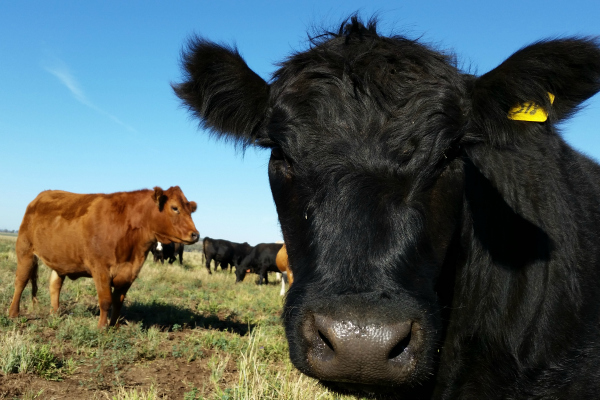Production systems involving ruminant animals have come under pressure from some sectors of the community concerned about climate change due to the production of methane (CH4, a greenhouse gas) by these animals. While methane has a much shorter life (12 years) in the atmosphere than carbon dioxide, the reason it attracts so much negative publicity is that methane is calculated to have a 25 greater fold impact on climate change than carbon dioxide. Much of the atmospheric methane is oxidised to carbon dioxide and water, but with general emission levels increasing since the industrial era, (as with carbon dioxide), there is only so much certain systems can deal with. So should we therefore be worried about the impacts of the methane from our livestock on climate change?
There are a number of reasons why we should question if ruminants are really the problem that they are thought to be:
- Methane production from animals feeding on pastures of healthy soils may be mitigated by methanotrophs or methanophiles.
- Ruminants can actually help to reverse climate change, when they are managed well. When done properly, we can sequester carbon from the atmosphere and place it in soils helping to reduce the threat of climate change, while also aiding the resiliency of the farmer. There are a number of options for further reducing carbon emissions, but there are very few options that offer a solution for reversing that which is already emitted. The active growth of a diversity of plants is the only genuine solution that I am aware of. To keep plants of grasslands actively growing so that they might sequester carbon means grazing from animals – something which I regularly refer to.
It is estimated that there are:
- 2700Gt of carbon in soils
- 575Gt of carbon in trees
- 848Gt of carbon in the atmosphere
It is estimated that we need to pull 258Gt1 of carbon out of the atmosphere to reverse climate change to pre industrial levels. You can see from the above figures that that would require an unfeasible amount of trees for that to be the sole solution. This amount of sequestration required however, as a proportion of what is in the soils currently, is a feasible place for the excess carbon to be placed. The soils are not only a safe place for this carbon, but the soils will actually benefit from the extra carbon being there. This is unlike our oceans, which currently hold more carbon that even our soils, but which are already suffering from acidification problems from the excess carbon dioxide that has already dissolved into them from our atmosphere. So, soils are a big part of the answer, and managed animals are an important part of affecting this change in soils.
What is a methanotroph / methanophile?
Methanotrophs or methanophiles are bacteria that use methane as their one and only energy source.
There is interest in these bacteria for their potential to aid climate change mitigation by reducing methane emissions from landfill and from geothermal power stations. But this is not why I am mentioning them here. I mention them due to their presence in soils and their link with our ruminant production systems.
According to Richard Evershed of University of Bristol, there are two types of methanotrophs:2
High capacity methanotrophs
These bacteria are adapted for growth in high methane (CH4) environments, such as landfills, wetlands etc. More than 90% of the methane produced in these environments is consumed by these bacteria. These methanotrophs are well studied, as they are able to be cultured. There is optimism that in being cultured they may be able to be used to reduce methane emissions from landfills.
Low capacity methanotrophs
These methanotrophs are found in grasslands, forests and agricultural land. These vary from those mentioned above in that they can live on very low levels of atmospheric methane. They are an extremely important sink for methane, but as yet are unable to be cultured in the lab.
These low capacity methanotrophs are the ones relevant to our grazing operations. They live in the soil and are able to oxidise methane from the and when we consider that we can’t simply culture and apply them in the field, we first need to understand how to create the right environment for them to thrive.
Due to the inability to culture these methanotrophs, there is not a vast array of detailed information about them. We do know however, that ‘inorganic fertiliser additions suppress CH4 oxidation linked to reductions in the methanotrophic bacterial populations, and that inorganic forms like manure actually enhance the soils ability for methane oxidation.3 The bacteria are not only sensitive to inorganic fertilisers, but to disturbances in general and tillage is likely also a major factor in affecting methanotroph populations. Long term Welsh trials of inorganic fertiliser application show that methanogenic bacteria numbers were reduced by 80%.4
Another trial found that grazing of an alpine meadow resulted in increased methane oxidation potential as well as an increase in the numbers of methanotrophs found in agricultural soils.5 While I recognise most of the worlds grazing lands aren’t alpine meadows, this research suggests that methanotroph levels increase with the introduction of grazing. Is this to the degree that the increase in methanotrophs negates the methane produced by the animals? There seems not to be clear numbers on this, but I suggest that more work needs to be done. I see reference to work by Professor Mark Adams, Dean of the Faculty of Agriculture at Sydney University that one hectare of pasture land could oxidise as much methane as emitted by 162 head of cattle in an entire year.6 The capacity of such a process is clearly dependent on many variables – both natural and man induced.
Of the research that I have seen in this area, it indicates that a well aerated soil that has avoided the inputs of inorganic fertilisers is required to enable the methanotrophs to effectively oxidise methane. Does nature strike the balance between methane output and the associated oxidation required when helped to do so through conscious management? The grazing management required for a well aerated soil that supports methanotrophs is consistent with that required for the sequestration of carbon into soils which will further offset any climate change impacts of the methane from ruminants. It’s not only about the balance between the methane producing animals and the methane consuming methanotrophs, it’s about the whole system, which includes the climate influencing effects that carbon can have and the potential for sequestering this in soils via actively photosynthesizing plants under livestock grazing systems. Wouldn’t it be great to see agriculture not only reduce its emissions, but also be part of the solution of reversing climate change?
I wish to not see livestock agriculture pushed in a direction of housing animals so that the methane can be captured and used for energy. What future for our grasslands and rangelands then? Yes, we acknowledge that poorly managed animals on rangelands have multiple negative effects, however animals managed well play a critical role in healthy, productive landscapes and removing the animals from it will create over resting of species and poor ecological outcomes long term.
References
1. Leu, A. Organic 3.0. The Next Phase of Organic Agriculture presentation. Quivera Conference 2015.
2&3. Evershed, R. Impact of Agriculture on the Soil CH4 Sink. http://www.slideshare.net/Sustainablefoodtrust/what-role-for-grazing-livestock-richard-evershed 23rd Nov 2015.
4. Evershed. R. Impacts of Agriculture on greenhouse methane capture by soil. http://www.bristol.ac.uk/cabot/research/casestudies/2012/24.html
5. Abell, G. et al. Grazing affects methanotroph activity and diversity in an alpine meadow soil. http://www.researchgate.net/publication/237823417_Grazing_affects_methanotroph_activity_and_diversity_in_an_alpine_meadow_soil 24th Nov 2015.
6. Jones, C. Soil carbon – can it save agriculture’s bacon? file:///C:/Users/User/Downloads/JONES-SoilCarbon%2526Agriculture(18May10)%20(2).pdf 24th Nov 2015.[/private]


G’day Kirrily. Thanks for another great article.
One thing I haven’t seen mentioned in this debate, which I think is very important, is the source of the carbon that is emitted.
When coal is dug up and burnt or methane from a coal seam is allowed to vent into the atmosphere, the carbon molecules released were from a geologically stable source and had been in place for millions of years, and can’t be returned within a shorter timeframe.
When a forest is cut down or a grassland is ploughed up and not allowed to revegetate, the carbon comes from a biologically stable source that has been there for hundreds or thousands of years. This carbon will stay in the atmosphere unless the forest or grassland is allowed to recover.
However when a cow burps the carbon molecules had come out of the atmosphere via the growth of a plant, and is thus returning to where it was only a few days ago in many cases (how quickly can a plant convert atmospheric CO2 to leaf tissue??). Thus cows are one part of a cycle rather than a one way transfer from geological or biological stable forms of carbon to atmospheric carbon.
I know it is not quite that simple, but unless i’m missing something I think the whole enteric emission thing is a bit of a furphy.